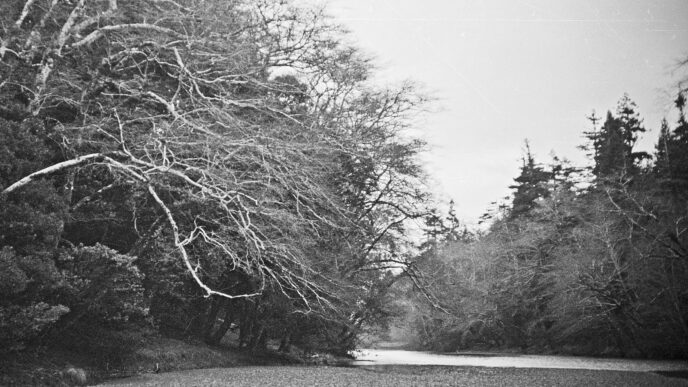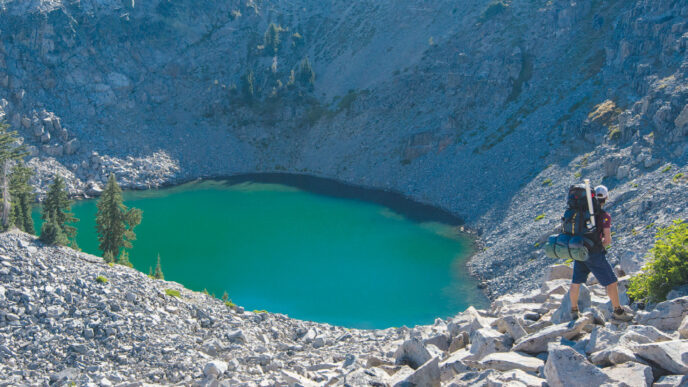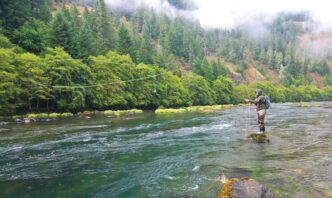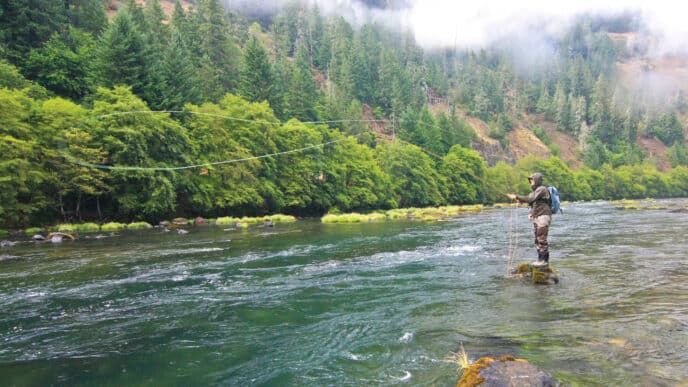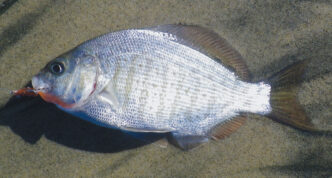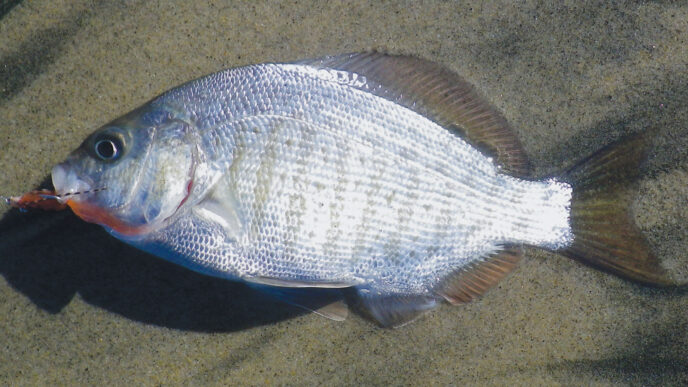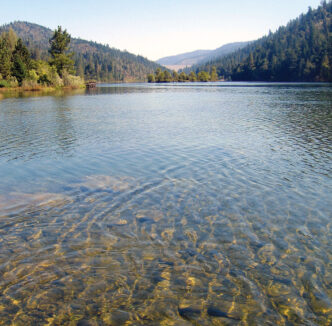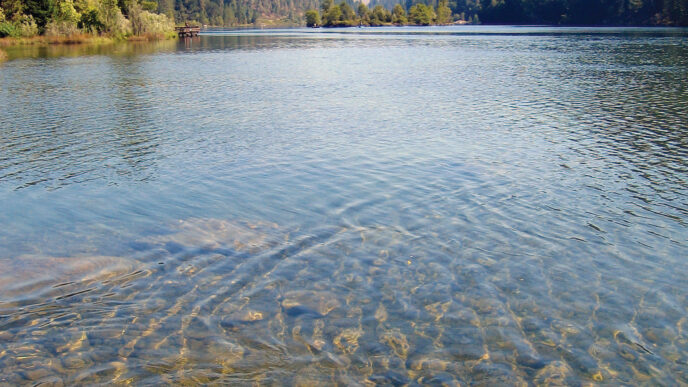My fishing partner and I were kicking in after a successful late-season outing at Lake Davis. As we dragged our float tubes up toward our truck, we saw a stringer of fish lying in the sand next to an SUV. They hadn’t been dressed and had been in the sun far too long. The skin on these magnificent trout had dried out and lost its silvery luster. I thought, “What a waste.” I had killed one fish late that afternoon, which would be our dinner after we started a roaring fire. I had dispatched it immediately and then had gutted and bled it. Next, I wrapped it in a wet cloth and refreshed the moisture every 15 minutes. Once back at the truck, I immediately rinsed the fish again, wrapped it in plastic wrap, and covered it with ice.
Though many fly fishers practice catch-and-release angling, there are times when some of us kill an occasional fish for the table. Most often, this occurs at a lake where trout are stocked annually with the intention of providing sport and being harvested. Saltwater fish, panfish in warmwater lakes, and fish that cannot be revived or are severely injured also can find their way to the table, as can fish from some high-altitude lakes and small streams overpopulated with stunted fish, often small brook trout. The overriding issue is whether or not the harvest will harm the fishery. Naturally, no one should be killing wild steelhead or fish in waters where the regulations prohibit the taking of fish.
If you harvest the occasional fish, it’s important to know how to care for it. If you’ve caught a fish that, for whatever reason, is destined for the table, it is imperative that you dispatch it in a quick, merciful way. Several whacks on the head will do the job. In Scotland, ghillies carried a wooden truncheon or “priest” to do the job. In a pinch, a soda or beer bottle, stick, rock, or the butt of a survival knife works. In my float tube, I use a pocket knife to pith the fish brain. Next I field dress the fish by gutting it and removing the large blood vessel that runs the length of the spinal cord. A thumbnail works, as does a small spoon. Rinse blood from the body cavity and wrap the fish in a moist rag or moisten it and or put it in a Zip-loc bag. When I get back to shore, I strip out the gills. When you gut the fish, take the opportunity to check the gullet and stomach. The contents yield lots of information. I carry a small vial for bug samples.
If I decide in advance to keep a fish, I try to do so later in the day to minimize time out of the cooling water and exposure to the atmosphere. My objective, after cleaning, is to keep the fish cool and avoid desiccation of the skin layer. My friend Mike Duffy owns a small fish market. He drives to Half Moon Bay twice a week to pick up fresh fish from the docks and from a trusted local broker. Mike ran his own boat for years, as well as a fish market, restaurant, and smokehouse. He is fastidious about every step in the process, from the point at which the fish is swimming in the ocean to its arrival at his client’s home, and that includes being concerned with food safety. He buys fish in the round, keeps it on ice, and butchers it after he gets back to his store in Grass Valley. Mike says, “Once you breach that skin, the breakdown process starts.” He wraps his fillets and steaks in plastic wrap or vacuum sealed before they go into his display case. When the fish is purchased, it stays in the plastic wrap and is given a layer of butcher paper and sealed. Fish that he buys from a broker comes in vacuum-sealed pouches and is sold unfrozen. It usually sells out that same day. Oxygen that contacts fish flesh, desiccation, and warm temperatures are the enemies.
My fly-fishing club in Livermore had an annual outing to an alpine Sierra lake off Sonora Pass at the 8,700-foot level. We would hike in for the day. Our camp cook passed out Zip-loc bags in the morning and directed each angler to catch five small brookies, gut and bleed the fish, and pack them in snow for the trek back to camp at a lower elevation. We always had a fabulous fish fry using a large wok and did the resource a favor by removing fish from an overpopulated lake. The fish came from cold water, were put on ice immediately, and were cooked shortly after arrival back at camp.
I fished the Central California coast for 15 years in a center-console skiff that had a live-well seat. Salmon often were our target, and our goal was to eat our fish the day it was caught, while it was fresh. Before first light, we dumped a 20-pound sack of ice in the live well and opened the drain to let in seawater to make an icy saltwater brine. We gutted and bled the salmon within 10 minutes of capturing them and placed them in the live well. Then I called my wife via radio telephone, during the early years, and later on a cell phone, to alert her that fresh fish was on the evening menu. Back at the dock, we drained the water off and added more ice for the trip home. We butchered the fish before we washed, flushed, and cleaned the boat. Often, I would invite neighbors or good friends over, and invariably they would say, “I’ve never had fish that tasted so good.” I made salmon lovers out of more than a few folks.
If you can’t eat fish the day it was caught, you can follow the protocols that I have described and protect the fish with plastic wrap. The flesh will retain its optimal quality for several days. You can choose either to hold it for a few days or freeze it immediately. To freeze fish, put it in a Zip-loc bag and carefully press out any air. Then wrap it in a layer butcher paper, which helps cut down on freezer burn.
Some advocate ice glazing. Dip your fish in water and then place it on a sheet pan that goes immediately in your freezer. Repeat the process several times until there is a quarter of an inch of ice glaze, then wrap it for a final freeze. I’ve found that this is even more difficult than it sounds. Home freezers operate around zero degrees. The commercial freezers used for this process are much colder. Leave ice glazing to the industry professionals. Their flash freezing, ice glazing, and vacuum packing techniques have improved to the point where commercially frozen fish can be a better product than fresh fish that has been in the display case too long.
Even if you just purchase fish at a grocery store, in a fish market, or directly from a boat in the harbor, it’s important to know how to evaluate the freshness of the offerings you find there. Years ago, I wrote an article for the Contra Costa Times on evaluating fish at the market. A reporter wanted to know where I shopped. I told her that sometimes I had to visit two or three markets to find what I was looking for and that often I passed on buying because I couldn’t find fish that met my standards.
Whether in the round, cut into steaks, or filleted, fish should look and smell fresh. I want the eyes to be clear and the gills to show bright red. The skin should shine and be free of mucus. A push into the flesh with a fingertip should rebound quickly. I was in France a few years ago, at a waterfront restaurant in Marseille. Our waiter brought the day’s fish to our table in an open basket. Close inspection met the above criteria. The fish smelled of the sea and was free of any ammonialike odor. We gave our waiter a thumbs up, and the bouillabaisse was heavenly. Too bad this practice isn’t in favor in the United States.
If I have frozen fish, I try to eat it within three weeks, and I have recipes that are specific to frozen fish and aquaculture salmon. Thaw the fish over a day or two in the refrigerator — when pressed for time, second choice is in a water bath. Never let fish sit on the counter for a day or thaw it in a microwave. I like frozen fish from Costco because of the rapid product turnover, but wherever you buy it, carefully inspect the product first. Always rinse thawed fish several times with cold water before cooking. A last-minute sprinkle with lemon juice or champagne vinegar brightens fish up.
Here are two fish recipes from my in progress cookbook project, Recipes From Jackrabbit Hill: Sierra Foothills Cooking in a Small Vineyard Setting.
Large Trout in Foil
For a freshly caught 17-inch or larger trout, stuff the body cavity with mandarin or navel orange slices. Add a few sprigs of cilantro and dust the inside of the body cavity as well as both sides of the skin with a heaping tablespoon of generic Indian curry powder. Give it all another light dusting with garlic salt. Drizzle the fish with high-quality extra virgin olive oil and juice from an additional orange, sprinkle with cilantro, and add a dash of fruity white wine. Double wrap the fish in heavy-duty foil and bake in an oven at 325 degrees or on the high rack of a gas-fired hooded grill, set on low, for 35 to 50 minutes, depending on the size of the trout. The foil method also works in camp on a grill rack over a bed of coals. This is a very forgiving way to cook fish.
When the fish is done, move it to a platter and peel the foil back. Use a large fork or pie server to peel back the upper layer of fish from the backbone. Next, grab the backbone and lift it out. It will come off very easily, leaving another layer of flesh. Reserve the residual juices and spoon them over a serving of rice. At home, we eat the skin. It is very rich in vitamins. This method cooks fish evenly throughout and produces a tasty, low-fat meal rich in the healthy omega 3 fatty acids that help keep our cholesterol and LDL levels within normal ranges.
Salmon Boats
This technique works for any size salmon fillet that still has its skin. It works with fresh as well as frozen fish. Wash the fillet, pat it dry, and set it aside. Fabricate a “boat” out of heavy-duty foil that is a bit wider and longer than the fillet. Turn up the four edges about three-quarters of an inch and oil the bottom of the boat with a generous amount of high-flash-point cooking oil such as peanut or safflower oil. Add the fillet, skin side down. Drizzle
Asian black vinegar on the fillet. Add another drizzle of low-sodium soy sauce and dust with garlic salt. Now drizzle the fillet with high-quality extravirgin olive oil and add some chopped cilantro. In a pinch, you can use Wishbone Italian Salad Dressing or Bernstein’s Restaurant Grade Italian. Many marinades will work well, including a favorite garlic, basil, Dijon mustard, and soy mixture.
On a gas grill, place the “boat” with the salmon on the grill rack over a burner flame set at low. Close the hood. If cooking over charcoal, spread the coals and let them burn down. Put the lid on the grill or cover the “boat” with a foil hood. Never turn the fish — it will sauté from below and bake from above. A thin fillet will cook in 18 minutes. A huge fillet from a 20-pound fish might take 25 to 28 minutes. Average fillets take 22 minutes. The cooking time depends on outside temperature and humidity, but the method is very forgiving in that both the thin and thick parts of a fillet remain moist. It is hard to mess up this recipe. Slip a large burger flipper or wide spatula between the darkened skin, which will stick to the foil, and the bottom of the fillet. It will glide along if you shuffle it a bit, and you can lift out the entire fillet and place it on a platter for a magnificent presentation. For big salmon or ling cod, I get a helper and use two or even three implements. Garnish with Meyer lemon slices, edible flowers, and fresh herbs. If my fillet came without its skin, which is a mistake, I substitute sheets of sushi seaweed between the backbone side of the fillet and my foil .
When you butcher a fish, save its backbone and the meat still attached to it. Brush the residual flesh with your marinade of choice and put it on the grill. When it looks done, pick the meat from the bones with a fork. I always save some of the smoke-flavored flesh for making salmon pâté or mousse, but your guests might beat you to the punch.
Yaks Koffee Shop in Dunsmuir
Review by Mike Koslosky
This cafe has only been in Dunsmuir for half a year or so, after moving up from Redding, where the owners, Michael and Nancy Kerns, had five establishments. They run a terrific cafe. Not only is the food first rate, but they make most of their own soups, sauces, dressings, sausage gravy, roast their own coffee, and have a bakery with fresh daily treats.
The interior is probably the coolest hand-painted design I have ever seen. And at 65 years of age, I have been in one heluva lot of cafes.
Linda and I ate there last Monday and now will always stop there to eat as we drive up and down I-5 between our home in Washington and the Bay Area. If you’ve already been there you can confirm what I’m saying. If you haven’t, get going, you’ll be glad you did.
Yaks Koffee Shop is located at 4917 Dunsmuir Avenue in the town of Dunsmuir. Hours are 7:30 A.M. to 7:00 P.M., Monday through Saturday, and 8:00 A.M. to 5 P.M. on Sunday. Phone (530) 678-3517; on the Web at http://www.yakskoffee.com. There is also a Yaks in Mt. Shasta (same hours) at 333 North Mt. Shasta Blvd.
Lunch, European Style
If readers want a simple, satisfying meal when on the stream, it’s hard to beat the European approach of f resh-torn hunks from a French-style baguette that are topped with salami and cheese. Add slices of onion for crunch and zip.
TAD ZUMWALT
Los Angeles
Duarte’s Tavern
By Richard Anderson
When I think back on the many, many fishing trips I’ve made over the decades, I rarely recall what I ate for sustenance and where I ate it. Surprisingly few places come to mind with any detail or opinion. There was that steakhouse in Dillon, Montana, where — shockingly for cattle country — the beef had the texture of my neoprene waders. Far better was the prime rib at the now long-gone Outpost, which was situated at the intersection of Highways 89 and 299, near Burney. I was learning then the skills to fish Hat Creek well, which tints everything from that time with the rosy hue of fond remembrance. No doubt this is why I also recall the gigantic “lumberjack’s breakfast” at nearby Twiggy’s, a converted drive-in that also vanished years ago, where my fishing buddy Bob and I would eat near to bursting to give us the energy to stay on the water until darkness fell.
And then there was that winter outing to the beaches of San Mateo County, a reminder of the discomfort and, oddly enough, pleasure of fishing in poor weather. Although my home in the city was socked in with fog, the urge to throw a line was too strong to resist, so down I-280 I drove, to Highway 92, then over the hill to Highway 1. The fog remained a constant presence, and in its dim gray light, one felt as if underwater, with the surface unseen far above.
The beaches on this January morning were empty, which focused all attention on the ocean and the land against which it beat. At the best of times, throwing a fly into the Pacific along the Northern California coast feels like the forlorn act of a fool — the sea so huge, so powerful, the distance one can cast so puny. But this is also a challenge, a dare — can one catch fish in churning, thumping surf that is nearly unreadable, where you should not wade more than a few feet from shore, and using tackle that makes the already poor odds even more dismal?
Of course you go for it. No question. That’s why you use fly gear in the first place, to catch fish with a method that, while often less than optimal, is beautiful to behold and a joy to perform.
And thus I walked the beach, casting into lanes behind or between waves, into quiet spots that might betray the presence of deeper water, and into any sheltered nook that looked as if it could hold a fish. All the while, the sun refused to show itself. If anything, the fog seemed to grow thicker, colder. At some point I realized it was time to reel up and head back, with nothing to show for the effort other than another notch on the belt of experience.
Just a short distance away sat the small town of Pescadero. Perhaps it had a place where I could get a late breakfast and remove the chill. I drove in, spotted an unassuming storefront with a sign that read “Duarte’s Tavern.” This happened so long ago that I no longer remember much about the joint. I slid into a chair at a table in a nearly empty bar. The television was tuned to a 49ers game. I ordered a beer, probably an Anchor Steam. One item on the menu caught my eye: fried smelt. Here I was, a fisherman in a town named for fishermen. Fish it would be.
The plate, when delivered, was stacked with deep-fried…bait. Tasty little things, they were. And a bit gritty with sand. But the place was warm, unpretentious; a nice refuge to escape the conditions outside. I leaned back in my chair, happy with where I was, knowing the morning had not been wasted at all.
Bad weather whets the appetite. The worse the conditions, the more satisfying and memorable the meal.
The restaurant at Duarte’s Tavern has received accolades over the years and accordingly draws many visitors. Its address is 202 Stage Road in Pescadero, which is two miles east of Highway 1 and roughly midway between San Francisco and Santa Cruz. It is open from 7:00 A.M. to 8:00 P.M. daily, and reservations are recommended (phone 650879-0464). Additional information can be found at http://www.duartestavern.com. Smelt are still on the menu.







